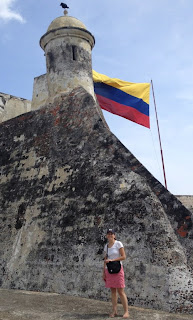| Our group led by our fearless guide on the left! |
Last weekend was a holiday weekend (Dia de la Raza, aka Columbus Day in the U.S., was celebrated on the Monday) and the occasion to return to nearby places I'd already been to but wanted to get to know better. San Basilio de Palenque was one place; Bocachica and the Island of Tierrabomba was another.
I really wanted to go for a long hike on the island but at the tourist office was told that wasn't possible. But then I learned that the parents of one of my students was from Bocachica; I told her that I wanted to go on a l o n g hike, like from one end of the island to another, and asked her if it could be done. She said of course and arranged for someone to lead us.
So, 8 of us (3 Colombians, a Colombian-American, 2 Yanks, a Mexican-American, & a German; love the international groups!) met up on Monday morning at 8:30. Of course the trip to Bocachica was only 20 minutes by boat, but for a variety of reasons, we didn't get there til 10:30. This is Colombia!
| Fort San Angel Rafael |
German started out by taking us through the town of Bocachica, up a hill to a fort called San Angel Rafael. The fort had a really nice view all around, had been restored about 12 years ago, & had an escape tunnel that led down to the beach! We didn't escape. We entered just the opening of the tunnel and encountered BATS which was kind of creepy, although three of the local girls who followed us in to the fort had no qualms about going through all of the tunnels that we had been a bit nervous about. After enjoying the history & the view, we wandered down to the other fort that I'd already seen during my last trip. I was starting to worry that I wasn't going to see new parts of the island or get my long hike in, despite the fact that German had said a few times "get ready to WALK!" I didn't need to fear...
| Blowhole! |
After lunch & a quick dip for some, we started heading inland and up. This is the rainy season on the Caribbean coast, which means that (normally) brief but heavy rainstorms are fairly frequent. We connected with the one road (dirt) that went across the island, which of course was very muddy due to the rains. A few people on motorcycles were coming at us from the other direction and were having a hard time getting through; the smart guy on the burro had no trouble at all though!
| We're going to get muddy! |
Our goal was another small village on the "Cartagena" side of the island, from which we'd see a view of the city and be able to get a boat back home. We made it there at about 5 pm, 7 hours after we started. One of my fellow hikers from Cartagena said that it was the best hike he'd ever done. We were muddy and sore, but it was really good, beautiful, and interesting.
From where we had arrived, we had a great view of the Cartagena skyline. In the foreground, just below where we were standing on Tierrabomba Island, you could see the very humble homes that people live in, then came the bay, then the luxury high rises of Cartagena. The discrepancy is always shocking. Wikipedia cites a World Bank study saying that Colombia is "among the most unequal Latin American countries in terms of wealth distribution" and a recent article in the local paper said that the GINI index (which measures wealth inequality) had risen by 10% in Cartagena in the past 16 years. That inequality was glaringly obvious to me this weekend.
I got my hike in, but got a lot more too.
From where we had arrived, we had a great view of the Cartagena skyline. In the foreground, just below where we were standing on Tierrabomba Island, you could see the very humble homes that people live in, then came the bay, then the luxury high rises of Cartagena. The discrepancy is always shocking. Wikipedia cites a World Bank study saying that Colombia is "among the most unequal Latin American countries in terms of wealth distribution" and a recent article in the local paper said that the GINI index (which measures wealth inequality) had risen by 10% in Cartagena in the past 16 years. That inequality was glaringly obvious to me this weekend.
| Compare: homes in the foreground with those in the background |
I got my hike in, but got a lot more too.
For more photos of Bocachica and Tierrabomba Island, click here.








